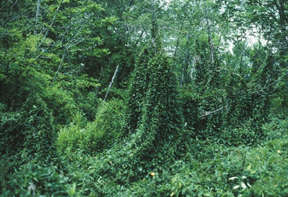Swallow-wort Biocontrols Pass Test
 |
|
Pastures, woods, wetlands, gardens, parks—swallow-wort could virtually swallow them whole. Photo by Leslie J. Mehrhoff, UConn. |
Entomologists Richard Casagrande and Heather Faubert helped rid a Rhode Island farm of cypress spurge, an invasive weed, in the late 1990s. The spurge is a pretty thing but a thug nonetheless, and poisonous to cattle. Their weapon: a cadre of hungry beetles, biocontrol agents so keyed into spurge they won’t eat anything else.
“Then,” says Casagrande (Univ. of Rhode Island), “along came swallow-wort.” Now Casagrande is leading a team to help find biocontrol foes to take on swallow-wort, research backed by Northeast IPM Partnership funds.
A Menace to Monarchs
Swallow-wort is ornery enough to land two botanical monikers. Vincetoxicum spells it out: this plant is poisonous. And Cynanchum means “dog strangler” or “to choke a dog”: take your pick. But swallow-wort has acquired new meaning in the Northeast. This rampant invasive smothers small trees and native toughies like goldenrod, practically swallowing them whole.
Because swallow-wort is related to native milkweeds, Casagrande’s grad student Jennifer Dacey wanted to see how well swallow-wort could provide for monarch butterflies. Results: 100 percent of monarch larvae died when hatching on black swallow-wort. “They stopped eating after a single bite,” says Casagrande.
Disinvite Dominating Dinner Guests
As with spurge, the best long-range solution is to put nature to work—in this case, to find something that eats swallow-wort for dinner, toxins and all. Grad student Aaron Weed worked with Swiss scientists to identify a handful of specialist plant herbivores, mainly beetles and moths, so tuned-in to swallow-wort they’re unlikely to touch other plants.
 |
|
Monarch butterflies are at risk in swallow-wort dominated landscapes. Photo by Jennifer E. Dacey, Univ. of Rhode Island. Courtesy Bugwood.org. |
Working off a TAG (technical advisory group) test-plant list approved by the USDA’s Animal and Plant Health Inspection Service, Casagrande’s team examined five possible biocontrol specialists in their quarantine lab, including two moths that evolved to feed on swallow-wort leaves. The researchers wanted to be sure these biocontrol insects wouldn’t jump to plants on the TAG list, since the last thing anyone wants is a new pest dominating the landscape.
“No-Choice” Tests Ensure Guests You Want
The TAG list includes, naturally, most native milkweed relatives and even their sixth cousins. “Luckily, none of our native plants are closely related to swallow-wort,” says Casagrande. “That makes it a great candidate for classical biological control.” The list also includes a suite of Eurasian plants you might expect these specialists to nibble at now and then, and even plants that could host these specialists’ relatives. The bar is high for these no-choice tests: biocontrols must prove they’ll die before they switch. Think of it as a severe background check—no one wants double agents on the payroll.
Results? Both leaf-eating moths “passed the acid test,” says Casagrande. But isn’t it risky to welcome in guests who die when the serving platter is empty? Considering how rampant swallow-wort is, these two could be fat and happy for many years to come. Next steps? Strategizing with U.S. and Canadian colleagues on best practices for releasing this deadly duo.
— by MARY WOODSEN
The Northeastern IPM Center promotes integrated pest management for reducing risks to human health and the environment. If republishing our news, please acknowledge the source (“From Northeast IPM Insights”) along with a link to our website.
